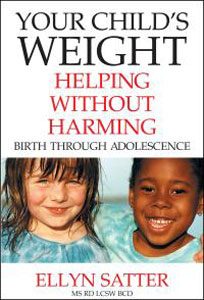

Family Meals Focus
The Ellyn Satter Institute Newsletter
Newborn Weight Gain: Trust or Control?
By Ellyn Satter, MS, MSSW, Dietitian and Family Therapist
For a PDF of this article.
Note from ES: The terms overweight and obesity are control paradigm words and not my own.
Growth over time is one of the best overall indicators of how things are going in a child’s world medically, nutritionally, developmentally, emotionally, and with respect to the feeding relationship. However, interpretation of that growth depends on underlying assumptions. The Family Meals Focus issue, Trust versus control in nutrition practice,1 outlined how nutrition and food selection issues play out in the two paradigms. This issue outlines how interpretation of growth varies depending on whether it is viewed through the lens of the trust paradigm or the control paradigm.
The trust perspective on growth
From the trust perspective, babies are born capable of eating as much as they need to grow in the way that is right for them. Their growth pattern can be assumed to be normal for them when feeding is going well: Parents properly interpret their sleep cycles, feed when the infant is wide awake and calm, and follow their feeding cues.2 Many infants take a full year before their growth canalizes, that is, before it settles down into a consistent trajectory on the growth chart. In the meantime, they are likely to do catch-up or catch-down growth, and their weights and heights may cross upwards or downwards across several percentiles.3-6
Feeding based on a developmentally appropriate Satter Division of Responsibility in Feeding (sDOR) assures that feeding is going well. sDOR provides children with appropriate support with feeding and avoids interfering with their eating. Given this optimum feeding, children’s growth after the first year tends to canalize.7 From the trust perspective that growth trajectory is normal for them even if it is above the 85th or 95th percentile or below the 15th or 5th percentile.
However, not all growth patterns represent normal growth. Still speaking from the trust perspective, abrupt and rapid growth divergence may constitute growth disruption and needs to be investigated to be sure that all is well in the child’s world. Correcting disruption corrects the child’s growth dysregulation and allows growth either to stabilize at a different trajectory or return over time to its original trajectory.
Kids who are subject to authoritarian, permissive, or neglectful feeding will do what they need to do to get fed.
The control perspective on growth
In contrast, from the control-grounded rapid weight gain (RWG) perspective, upward weight percentile crossing in the first year is undesirable. The premise of the RWG research of the last 15 years is that early upward percentile crossing correlates with high body weight five to ten years later and that bottle-feeding exacerbates this tendency.3-6, 8, 9 These judgments are based on control-oriented application of policy-defined BMI cutoffs (≥85th/95th percentile) categorizing high body weight as overweight/obesity. Solutions to the “RWG problem” include attempting to identify “obesogenic feeding practices,”10 and intervention designed to prevent RWG.11
Trust newborn catch-up and catch-down
The data shows that newborn growth takes many forms and doesn’t lend itself to prediction and tracking. Entertain yourself by considering some of the ways that babies grow.
- Children who were larger at birth tended to grow less rapidly; those who were smaller at birth tended to grow more rapidly.12
- Of almost 45,000 babies followed from 1 to 11 months, 60% crossed upward one weight-for-length percentile, 40% crossed upwards two or more percentiles. Twenty-one percent crossed downwards.3
- Low birth weight babies (less than 5.5 lb.) and those born prematurely tended to rapidly cross upwards across both weight and height growth percentiles during the first six months. Their weights and heights subsequently stabilized at the higher levels.5, 6
- Babies whose weight was higher at birth and those born at term tended to grow more slowly. 4
- From 6 to 12 months, the weights and lengths of both rapidly and slowly growing infants tended to decrease across percentiles.6
Trust: Rapid gainers tend to get bigger
Rapid weight gain is defined in the RWG studies as a positive change in the weight for age z-score greater than 0.67 between two different ages in childhood. However rapid growth is defined, the law of statistical averages says that babies whose rapid growth brings them to higher percentiles by the end of first year will tend to be larger as they get older. In addition, whether they grow relatively rapidly or slowly, 15% of children will achieve growth that is above the 85th percentile, 5% achieve growth above the 95th percentile. It is predictable that children whose growth canalizes at above-median levels will have above-median BMIs as adults. Adult BMI above the median, that is above 25, is considered by health policy makers to be overweight. Adults with BMI ≥35 have a lower mortality risk than those with BMI ≤ 25.13
Weights, heights, and BMIs of infants who gain rapidly tend to canalize at higher levels after the first year. From the trust perspective, canalizing constitutes normal growth, although it is never wrong to check out that all is well in even a consistently growing child’s world.
- Children who grow rapidly as infants tend to be heavier when they get older and on average are more likely to reach BMI ≥85.th4-6
- Just over 5% of almost 28,000 infants plotted at or above the 95th percentile by age 7. Those who grew rapidly as infants were about 1.5 times likelier to reach BMI ≥95.9 Five percent of children plotting at BMI ≥95 is consistent with statistical predictions.
- A study of 20 to 32 y/o adults who had been formula-fed as infants showed correlations between rapid weight gain during the first week and the first 112 days with above-median adult BMI (≥BMI 25).8
- A study of over 1000 British infants considered not only absolute growth, but also growth composition. Rapid weight gainers, who also enjoyed eating and were demanding with food, had higher BMIs because they were taller and leaner at seven to eight years of age, not fatter. Researchers observed that parents were more likely to discontinue breast-feeding and start solids early in response to this rapid early weight gain, not that ceasing breastfeeding and/or early solids introduction caused the rapid weight gain.14
- Four hundred 9 y/o studied after 50 years found correlations between early and later heavy build (leanness and heaviness independent of fatness). Adults with heavy build had significantly lower blood lipids and glucose and women had lower blood pressures. Being thin in childhood offered no protection against adult fatness and the thinnest children tended to have the highest adult degenerative disease risk at every level of adult obesity.15
Control: Rapid gainers are at risk
The above evidence that rapidly gaining children naturally tend to become larger later in life takes on ominous significance for the control paradigm folks. From the control perspective, RWG is a risk factor for overweight/obesity, a risk that is exacerbated by bottle-feeding. Using that frame of reference, RWG researchers interpret the growth data we just reviewed in quite a different way. Rather than saying big, rapidly growing babies tend to be big later in life and that’s just fine, the control perspective is that big, rapidly growing babies tend to be overweight/obese later on and that’s a problem.3-6, 8, 9
Such control-based thinking leads to systematic feeding errors. The INSIGHT study was established to prevent RWG by discouraging parents from promptly feeding fussing babies and from early introduction of complementary foods. It also coached parents in getting older babies and toddlers to follow a “healthy eating pattern” and limit portion sizes. At age one year, infants participating in the INSIGHT study showed weight gain percentages of 1 standard deviation below the mean, with 5.5% weighing at or above the 85th percentile at age 1 year.11 Fifteen percent would be statistically predictable. By age nine years INSIGHT graduates’ average BMIs regained to the mean and slightly above it.16 Growth of nine year olds appeared to be seeking their normal trajectories, although they may be on their way to overshooting.
How can a practitioner monitor/support growth?
Depend on monitoring the infant’s world to determine whether growth is proceeding well, paying particular attention to feeding dynamics. Kids who are subject to authoritarian, permissive, or neglectful feeding will do what they need to do to get fed. Be alert to interference and/or lack of support. Unusually small and prematurely born infants tend to attract pressure to eat more, but parents and practitioners who are tuned in to RWG research may try to restrict them to prevent normal catchup growth. Pressured or restricted infants and children lose track of their internal regulators and growth may dysregulate. Monitor growth after the first year to determine whether the child’s growth canalizes or whether it continues to dysregulate as a result of earlier errors in feeding. Parents and professionals may react to continued weight dysregulation by applying even more countervailing pressure and perpetuating growth dysregulation. Trying to get the child to eat more, less, or different food represents countervailing pressure.
In the best of all worlds, this cascade of feeding errors can be prevented by teaching parents sDOR based positive and responsive feeding from the first. Parents and health professionals can be supported in observing but not interfering with growth. Growth dysregulation after the first year can be addressed by detecting and addressing disrupting forces in the child’s world, with particular attention to feeding errors, and establishing sDOR. The Feeding with Love and Good Sense VISION Master Class17 teaches assessment and intervention.
The take home message
Relax, trust children, teach sDOR, and consider growth to be a spectator sport. “It ain’t over,” said Yogi Berra, baseball great and home-spun philosopher, “til it’s over.” J.M. Tanner, physician and major force in bringing about modern growth assessment, was grounded in trust that children know what they are doing. Stop for a moment to reflect on the profound difference between prevailing thinking and Tanner’s trusting view of growth:
“A striking and fundamental property of human growth is that it is self-stabilizing or, to take another analogy, target seeking. Children, no less than rockets, have their trajectories, governed by the control systems of their genetic constitution and powered by the energy absorbed from the environment. Deflect the child from its natural growth trajectory by acute malnutrition or sudden lack of a hormone and a restoring force develops, so that as soon as the missing food or the absent hormone is supplied again, the child hastens to catch up toward its original growth curve. When it gets there, the child’s growth slows down again, to adjust his path into the old trajectory once more. ”7
References
- Satter E. Family Meals Focus #120: Trust Versus Control in Nutrition Practice. 2025. https://www.ellynsatterinstitute.org/family-meals-focus/fmf-120-be-relaxed-and-positive-about-eating-and-feeding/
- Satter E. Chapter 7: Understanding your newborn. Ellyn Satter’s Child of Mine: Nurturing a Confident and Joyful Eater. Kelcy Press; 2025.
- Taveras EM, Rifas-Shiman SL, Sherry B. Crossing growth percentiles in infancy and risk of obesity in childhood. Arch Pediatr Adolesc Med. 2011;165:993–998.
- Zheng M, Hesketh KD, Vuillermin P. Determinants of rapid infant weight gain: A pooled analysis of seven cohorts. Pediatr Obes. 2022. doi:10.1111/ijpo.12928
- Flores-Barrantes P, Iguacel I, Iglesia-Altaba I. Rapid weight gain, infant feeding practices, and subsequent body mass index trajectories: The CALINA Study. Nutrients. 2020. doi:10.3390/nu12103178
- Li YF, Lin SJ, Chiang TL. Timing of rapid weight gain and its effect on subsequent overweight or obesity in childhood: findings from a longitudinal birth cohort study. BMC Pediatr. 2020. doi:10.1186/s12887-020-02184-9
- Tanner JM. Growth as a target-seeking function catch-up and catch-down growth in man. In: Falker F, Tanner JM, eds. Human Growth: A Comprehensive Treatise. Plenum Press; 1986:167–178.
- Stettler N, Stallings VA, Troxel AB. Weight gain in the first week of life and overweight in adulthood: A cohort study of European American Subjects fed infant formula. Circulation. 2005;111:1897–1903.
- Stettler N, Zemel BS, Kumanyika S. Infant weight gain and childhood overweight status in a multicenter, cohort study. Pediatrics. 2002;109:194–199.
- Leerkes EM, Buehler C, Wideman L. Biopsychosocial predictors of rapid weight gain from birth to 6 months. Pediatr Obes. 2024. doi:10.1111/ijpo.13170
- Savage JS, Birch LL, Marini M. Effect of the INSIGHT responsive parenting intervention on rapid infant weight gain and overweight status at age 1 year: A randomized clinical trial. JAMA pediatrics. 2016;170:742–749.
- Falkner F, Tanner JM. Human Growth. In: Tanner JM, ed. Growth as a target-seeking function: catch-up and catch-down growth in man. Plenum; 1986:167–179.
- Flegal KM, Kit BK, Orpana H. Association of all-cause mortality with overweight and obesity using standard body mass index categories: a systematic review and meta-analysis. JAMA. 2013;309:71–82.
- Wright CM, Cox KM, Le Couteur A. How does infant behaviour relate to weight gain and adiposity? Proc Nutr Soc. 2011;70:485–493.
- Wright CM, Parker L, Lamont D. Implications of childhood obesity for adult health: findings from thousand families cohort study. British Medical Journal. 2001;323:1280–1284.
- Paul IM, Barton JM, Anzman-Frasca S. Long-term effects of a responsive parenting intervention on child weight outcomes through age 9 years: the INSIGHT randomized clinical trial. JAMA pediatrics. 2025. doi:10.1001/jamapediatrics.2024.6897
- Satter E. Feeding with Love and Good Sense VISION Workshop: Assessing and Treating Childhood Feeding Problems. Ellyn Satter Institute. 2025. https://www.ellynsatterinstitute.org/education/workshops-keynotes/feeding-with-love-and-good-sense-vision-workshop/
Explore
For more information for parents about normal growth and protecting themselves against interference, see Your Child’s Weight: Helping Without Harming .
Address weight wisely and well
- Avoid restriction
- Children know how much they need to eat
- Follow Satter’s Division of Responsibility in Feeding(sDOR)
- Raise a healthy child who is a joy to feed
- Resolve the weight dilemma
Related issues of Family Meals Focus
- Baby-led weaning
- Big baby, big parents: No problem!
- Breastfeeding hullabaloo
- Catchup growth: Normal for premature babies
- Early infant weight gain, obesity, and adult disease
- Feeding in your baby’s first year
- Pureed food in pouches: boon or bane?

